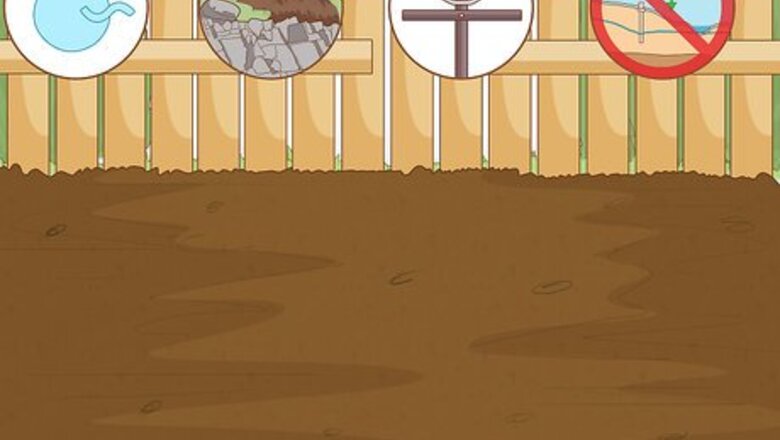
views
Planning Your Bunker
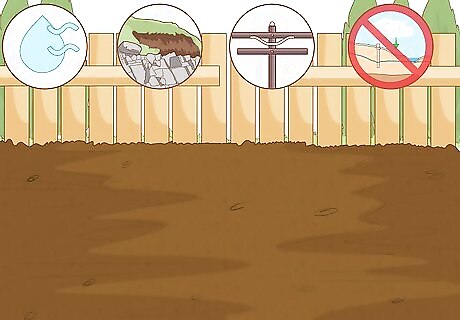
Choose a dry location with gravel soil for your underground bunker. Locate an area with soil low in clay and water. Rocky soil is fine but more difficult to excavate, so be prepared for more work if you choose this soil type. Avoid areas with natural gas pockets, bedrock, electrical circuits, and shallow water tables. Avoid locations at the bottom of a steep slope. If your only option is soil with lots of clay, install a French drain.
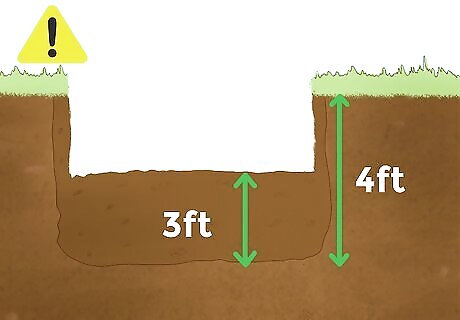
Dig a hole up to 4 ft (1.2 m) deep to check the water table level. Thrust your shovel into the ground and move it back and forth and side to side to loosen the soil. Once it's loosened, start digging and continue until it's 4 ft (1.2 m) or you notice water start to enter—the entrance height is the water table level. If you reach 4 ft (1.2 m), leave the hole and see how much water fills it after 1 hour—the water table level is the level that the water fills up to. Repeat this process around the bunker area and average your measurements to get an estimate of the water table level. Don't dig your bunker in an area with a shallow water table, which is 3 ft (0.91 m) or less.
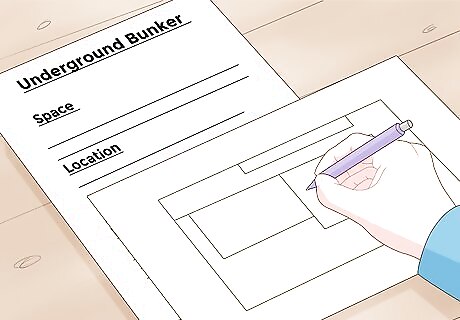
Draw a floor plan for your underground bunker. Before jumping into anything, ask yourself how big you want your bunker to be. Is it going to fit more than 1 person? How much space do you want? What are you going to put in your underground bunker? After answering these questions, sketch a floor plan along with the length, height, and width. Designate locations for the bathroom, kitchen, washroom, and common area. Consider the furniture that you want to add, such as couches, chairs, and beds. Write or draw each item to get a feel for where everything will be located.

Purchase a shipping container for a simple structural solution. The shipping container acts as the main body of the bunker and is the least labor intensive option for structure. Contact local shipping container companies and select a product with enough space that fits in your price range and needs. If you want, purchase multiple containers for a larger bunker. Standard shipping containers are 8 feet (2.4 m) wide, 8.5 feet (2.6 m) high, and one of two lengths: 20 feet (6.1 m) and 40 feet (12 m). Ask about purchasing used shipping containers for a cheaper alternative. Double-check with your landlord or landowner that you can build your bunker prior to having your container shipped. Shipping containers cost between $3,000 to $5,000 USD
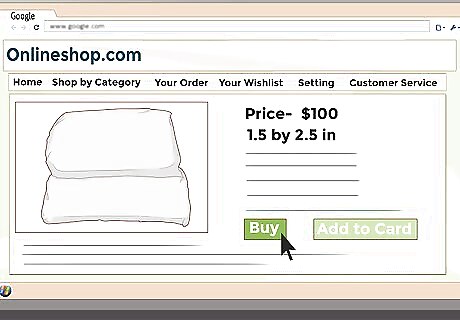
Buy 1.5 by 2.5 in (3.8 by 6.4 cm) earthbags for a low-cost solution. Earthbags are low-cost structural materials that can be purchased from online suppliers. If you're looking for the simplest method of creating your bunker structure, this is the way to go. After determining the length and width of your bunker, buy the appropriate number of bags needed to cover this space. Consider a bunker that is 240 feet (73 m) long and wide: it requires 1,152 bags for both the length and width—240 feet (73 m) divided by 2.5 inches (6.4 cm)—which is a total of 2,304 for 1 length and 1 width. This means that total amount of bags per layer is 2,304 x 2 (since there are 2 lengths and widths 2 per layer), or 4,608. Multiply the total number of bags needed per layer by the number of layers for the total bags for your structure. For example, if each layer requires 4,608 bags and you need 6 layers, you need 27,648 earthbags in total (6 x 4,608). Earth bag height will vary depending on how they're filled. After determining how many bags you need per layer, fill up one bag and measure it's height. Now, use this to determine how many layers you need. For example, if it's 1.5 foot (0.46 m) tall and you want a 15 foot (4.6 m) tall bunker, you need 7.5 layers (15/1.5). Soil costs between $12 to $18 USD per cubic yard.
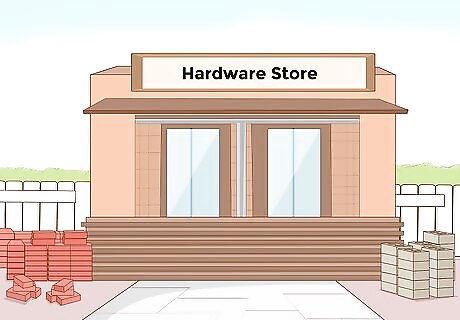
Build your bunker from cinder blocks or bricks for better insulation. Head to a home hardware store to purchase cinder blocks or bricks for a very affordable price. Not only are they relatively cheap compared to the more expensive materials, but they are also sturdy, easy to install, and great for insulation. Select bricks or cinder blocks if you live in an area with extremely cold weather during the winter. Purchase enough cinder blocks or bricks for each layer of your bunker. For example, if your bunker is 10 feet (3.0 m) long, wide, and high and your cinder blocks are 1 foot (0.30 m) long, wide and high, you need 40 for each layer (a total of 2 lengths and 2 widths) across 10 layers high for a total of 400 (40 x 10).
Digging and Constructing Your Bunker
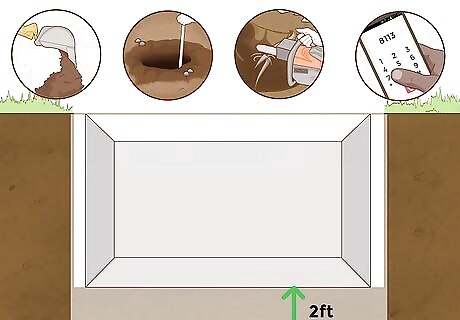
Dig a hole 2 feet (0.61 m) deeper than your bunker's height. Thrust your shovel down into the soil and move it forward and backward and side to side to loosen it. After loosening it, grasp the center of the handle with your non-dominant hand and grip the top of it with your dominant hand. Now, start digging your bunker hole from the perimeter of your bunker hole and move inward. Use your foot to firmly press straight down onto the shovel. Use a reciprocating saw or the tip of your shovel to saw through large roots. Loosen rocks with a steel bar. Consider hiring or renting heavy equipment to dig your hole. Call 811 3 to 4 days prior to digging to make sure you can do so without damaging underground electrical structures or piping.
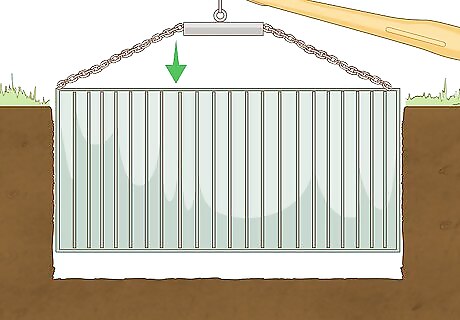
Place your shipping container into the hole if you're using one. Speak to the company you purchased your container from about shipping costs and procedure. Local companies will be cheaper, while international companies will be significantly more expensive. Most companies charge a flat rate per 1 mile (1.6 km).
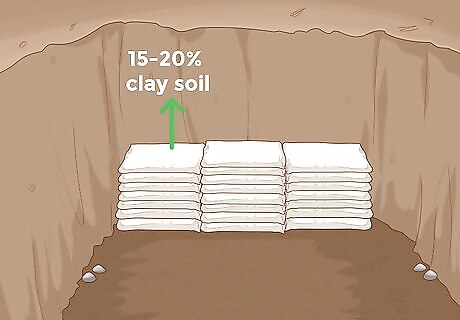
Fill and stack your earthbags with 15-25% clay soil if applicable. If you're making an earthbag structure, head to a local garden or big-box store and look for a sandy soil product with the appropriate clay levels. The rest of the soil should be made mostly of sandy aggregate. Now, start stacking the first row of bags. Afterward, start stacking your second row, making sure that each bag covers 1/2 of the 2 sandbags underneath it. Continue this process until the top of your sandbags are level with the ground Although 5-35% clay works too, the ideal amount is 15-25%, so stick to that whenever possible. Don't use heavy clay as it will contract when it dries and expand when wet. Ask a garden store worker for soils that are used for cob, rammed earth walls, and adobe blocks. Dump out any soil from your sandbags as needed to create corner pieces.
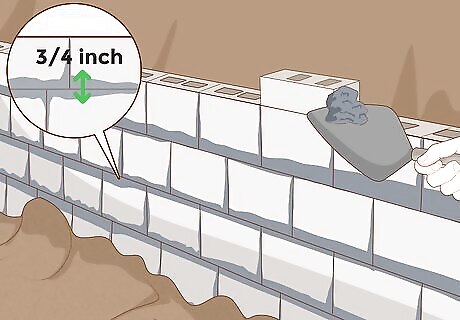
Lay bricks or cinder blocks and attach each piece with mortar for this type of bunker. Start placing your bricks onto a concrete foundation and attach each piece with ⁄8 inch (0.95 cm) of mortar. Work your way up about 2 to 3 courses on each side of the brick lines to create a shallow "U" before filling the middle. Double-check that you have enough cinder blocks or bricks for each layer of your bunker before starting. Your foundation should be the same length and width as your bunker structure and about 1 foot (0.30 m) deep. Use a spirit level to check the leveling after every 4 to 5 bricks. Stagger each layer or brick with a half piece to give it stability.
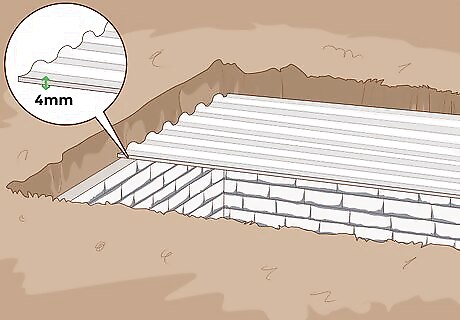
Use 4 mm (0.16 in) sheet metal roofing for earth bag or cinderblock structures. Sheet metal is the best roofing material if you're not using a shipping container. Wood isn't recommended for a roof due to its susceptibility to rot and weathering. If you're on a tight budget and want to purchase wood, make sure you use pressure treated wood.
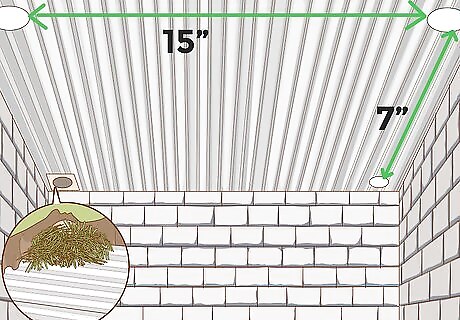
Install air vents in your roof. Find the net free area (NFA) of your vents, compare it to your bunker's square footage, and make sure the NFA is more. If not, add more vents until the total NFA is more than the square footage. Afterward, outline 7 by 15 inch (18 by 38 cm) rectangles on the ceiling for each vent. Now, drill holes into the outside corners of the rectangle and then remove it using a jigsaw. Always start by inserting the blade through one of the holes. Afterward, place a soffit vent over the rectangular holes and drill it into place with 4 to 6 screws. Cover the air vents on the surface with brush and rocks. Always start by installing the corner screws of the vents for stability. Set your saw to medium speed and always follow the outline slowly and carefully. Invest in an air filtration system for maximum air quality.
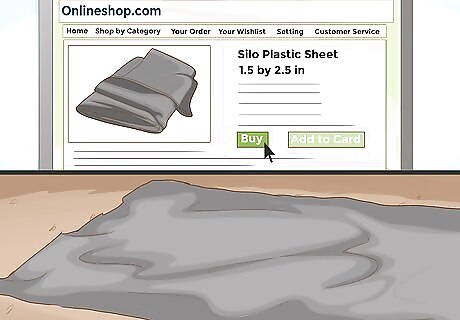
Cover your bunker with 5 to 6 mm (0.20 to 0.24 in) silo plastic. Silo plastic protects your bunker from water and other environmental waste while still allowing oxygen transmission. Purchase silo plastic from an online supplier for the best options. Multiply your bunker's length by its height to get the area of the roof you need to cover and purchase at least this amount. Weight the silo plastic down with gravel bags, tires, tire sidewalls, or other ballast material. Purchase 2 layers of silo plastic for extra protection. Swap silo plastic with a plastic tarp or cover for a cheaper alternative. However, bear in mind it won't be as effective.
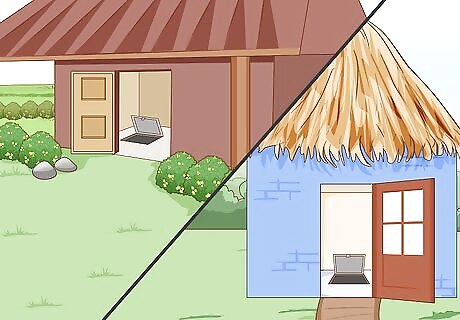
Hide the roof of your underground bunker from view. To prevent people from discovering your bunker, cover it with dirt and local fauna. Try your best to ensure that it blends into the surrounding environment as much as possible. Use tire sidewalls as opposed to tires whenever possible to prevent water buildup and rodent habitat formation. Build a shed on top of your bunker's entrance to conceal it. Place an outhouse on top of the entrance to your bunker. Add some bushes and rocks from your excavation.

Power your bunker with batteries, solar panels, and generators. Invest in no less than eight 6-volt gel-cell batteries in your bunker at all times. In addition, consider investing in solar panels and electrical generators for long-term power sources. Just remember to run your electrical generator outside when you need to use it. Use batteries to power lights and radio communication for the highest efficiency. Choose diesel generators as opposed to propane or gasoline. Invest in a diesel generator 2kW or smaller to charge your batteries. Call a local power company and inquire about installation costs.
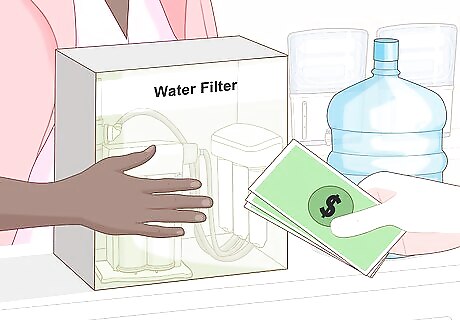
Invest in water tanks, filters, and heaters. You'll be outfitting your bunker with a toilet later, so you can focus on creating clean water or your consumption. Purchase a water tank to store your water and consider investing in a filter and heater. Skip the water heater if you don't mind cold water, but remember that you'll be missing out on hot water during the winter.
Outfitting and Stocking Your Bunker
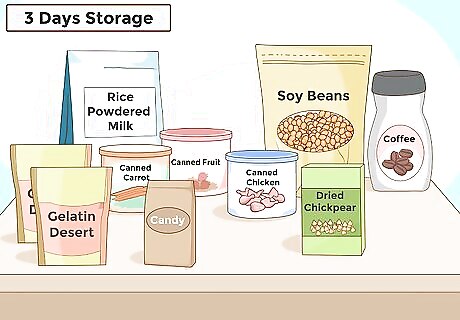
Fill your bunker with at least 3 days' worth of non-perishable foods and water. Start by filling your bunker with 3 day's worth of food and gradually add to it over time. Dehydrated meals, canned goods, dried pemmican, and rice stored in Mylar bags are all great choices, but anything with a long shelf life works. Bottled water is the simplest option, although you can invest in a water tank if you're willing to spend the money. If you're planning to house more than one person, be sure to account for extra food and water. Some canned foods examples include yams, carrots, peas, green beans, fruits, chili, chicken, turkey, tuna, and salmon. Dry foods you can purchase include raisins, mangos, apples, apricots, rice, flour, nuts, cereal, granola, powdered milk, and pet kibble. Buy some crackers, beans, canned meat, dried chickpeas, and gelatin desserts. Don’t forget some comfort foods, such as your favorite candy, tea, or coffee.
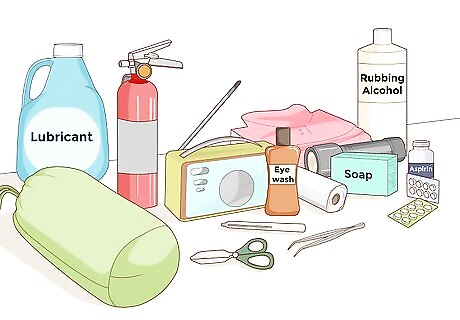
Stock your bunker with survival gear. Flashlights, a radio (self-powered or battery-powered), toilet paper, soap, fire extinguisher, and clothing are all the basics. In addition, you should stock some tweezers, scissors, a thermometer, latex gloves, and lubricant. Keep a stash of non-prescription drugs like aspirin, antacids, laxatives, eye wash, rubbing alcohol, and antiseptic.
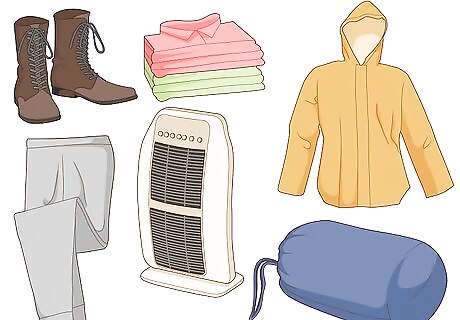
Create a sleeping area for rest. Be sure to add some blankets or sleeping bags, one change of clothing for each person, work boots or sturdy shoes, thermal underwear, and rain gear. Aside from these basics, add whatever else you want for comfort. Add some portable heaters for winter weather.
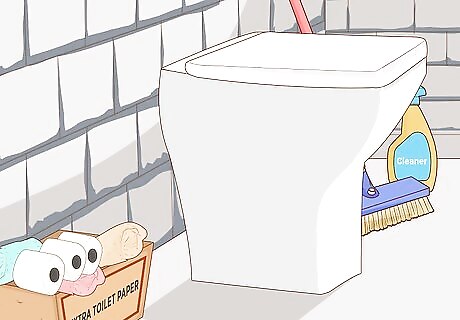
Add a portable camping or composing toilet to your bathroom area. Portable camping toilets require you to get rid of the waste yourself, while composting toilets turn it into fertilizer. Obviously, the latter is more ideal for long-term stays and situations when you can't leave your bunker. Stock your washroom area with toilet paper and cleaning supplies.
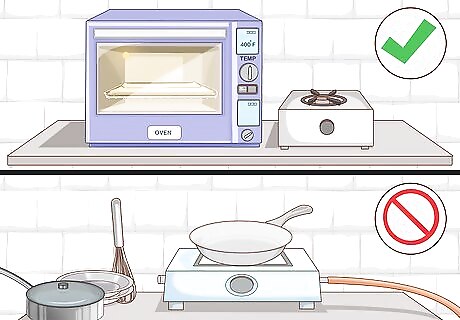
Stock your kitchen area with cooking tools. Start by stocking your kitchen with an electric burner or microwave oven—never propane or gas stoves, which create dangerous levels of carbon monoxide. For emergency situations, keep a marine alcohol stove handy. Purchase alcohol fuel from a marine or hardware store. Keep your utensils, pots, pans, and other cooking supplies in your kitchen area.
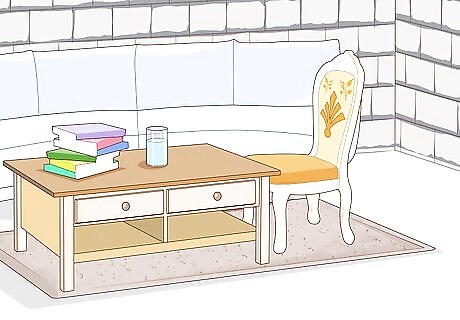
Create a common area for relaxing. Add a small carpet, couch, and some chairs to relax. Afterward, add some entertainment—cards, board games, books, a television, video games, movies, dominoes, and anything else to keep you occupied. Add a small coffee table to make your bunker homier.



















Comments
0 comment